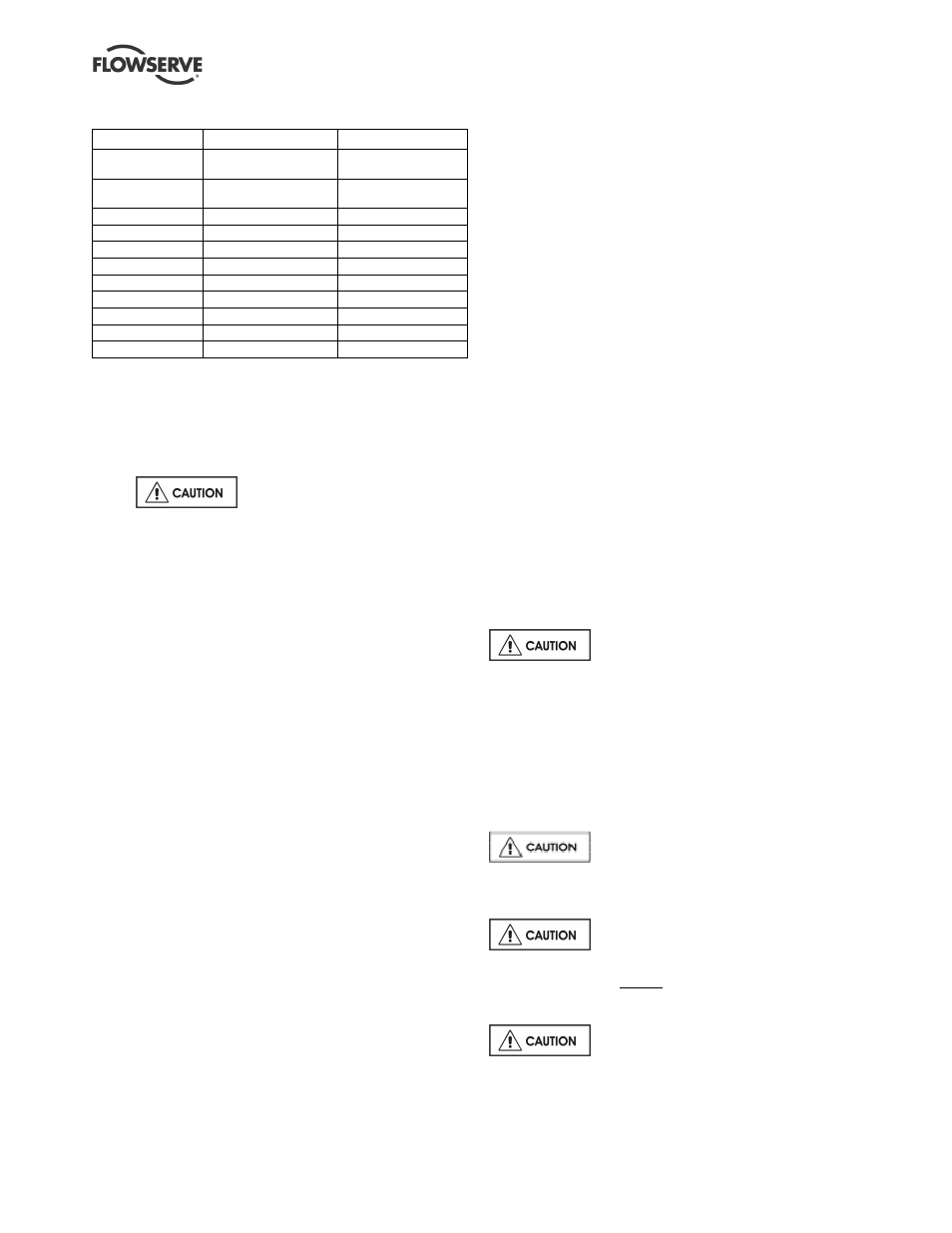3 impeller clearance, 4 direction of rotation – Flowserve Chemstar standard User Manual
Page 17

CHEMSTAR USER INSTRUCTIONS ENGLISH 71569185 02-10
Page 17 of 44
flowserve.com
5.2.3 Recommended grease lubricants
Grease
NLGI 2 *
NLGI 3
Temp. range
-20 to +100 ºC
(-4 to +212 ºF)
-20 to +100 ºC
(-4 to +212 ºF)
Designation
acc. to DIN
KP2K-25
KP3K-20
BP
Energrease LS-EP2
Energrease LS-EP3
Elf
Multis EP2
Multis EP3
Fuchs
RENOLIT EP2
RENOLIT EP3
ESSO
Beacon EP2
Beacon EP3
Mobil
Mobilux EP2
Mobilux EP3 **
Q8
Rembrandt EP2
Rembrandt EP3
Shell
Alvania EP2
Alvania EP2
Texaco
Multifak EP2
Multifak EP3
SKF
LGEP 2
-
* NLGI 2 is an alternative grease and is not to be mixed with other
grades.
** Standard pre-packed grease for fitted antifriction bearings.
5.2.4 Recommended fill quantities
Refer to section 5.2.2, Bearing sizes and capacities.
5.2.5
Lubrication schedule
5.2.5.1 Oil lubricated bearings
Normal oil change intervals are 4 000 operating hours
or at least every 6 months. For pumps on hot service
or in severely damp or corrosive atmospheres, the oil
will require changing more frequently. Lubricant and
bearing temperature analysis can be useful in
optimizing lubricant change intervals.
The lubricating oil should be a high quality oil having
oxidisation and foam inhibitors, or synthetic oil. Do
not use detergent oil.
The bearing temperature may be allowed to rise to
50 ºC (90 ºF) above ambient, but should not exceed
82 ºC (180 ºF) (API 610 limit). A continuously rising
temperature, or an abrupt rise, indicates a fault.
When oil mist lubrication is specified the bearing
housings are furnished with a single top inlet tap, a
vent hole at the outboard bearing and a bottom drain.
Pumps which handle high temperature liquids may
require their bearings to be cooled to prevent bearing
temperatures exceeding their limits. Oil cooling with
regular ambient conditions is normally required for
pumpage above 175 ºC (350 ºF) and up to 260 ºC
(500 ºF). Temperature applications above 260 ºC
(500 ºF) are normally not possible. Consult Flowserve
if unsure of correct method or arrangement.
5.2.5.2 Grease lubricated bearings
When grease nipples are fitted, one charge between
grease changes is advisable for most operating
conditions; ie 2 000 hours interval. Normal intervals
between grease changes are 4 000 hours or at least
every 6 months.
The characteristics of the installation and severity of
service will determine the frequency of lubrication.
Lubricant and bearing temperature analysis can be
useful in optimizing lubricant change intervals.
Sealed bearings are optional. These bearings are
packed by the bearing manufacturer and should not
be relubricated. These should be replaced on a
regular maintenance schedule.
The bearing temperature may be allowed to rise to
95 ºC (203 ºF) maximum during the running-in period.
This should be followed by a steady fall in
temperature to around 50 ºC (90 ºF) above ambient
after 1.5 to 2 hours of operation as the grease soap
settles. A continuously rising temperature, or an
abrupt rise, indicates a fault.
For most operating conditions, a quality grease
having a lithium soap base and NLGI consistency of
No 2 or No 3 is recommended. The drop point
should exceed 175 ºC (350 ºF).
Never mix greases containing different
bases, thickeners or additives.
5.3 Impeller clearance
Impeller clearance was set at the factory based on the
temperature given in the customer datasheet at the time
the pump was purchased. For setting instructions, see
section 6.7, Setting impeller clearance.
5.4 Direction of rotation
Serious damage can result if the
pump is started or run in the wrong direction of
rotation. These pumps turn clockwise as viewed from
the motor end.
The pump is shipped with the coupling
element removed. Ensure the direction of rotation of
the motor is correct before fitting the coupling element.
Direction of rotation must correspond to the direction
arrow.
If maintenance work has been carried
out to the site's electricity supply, the direction of
rotation should be re-checked as above in case the
supply phasing has been altered.
